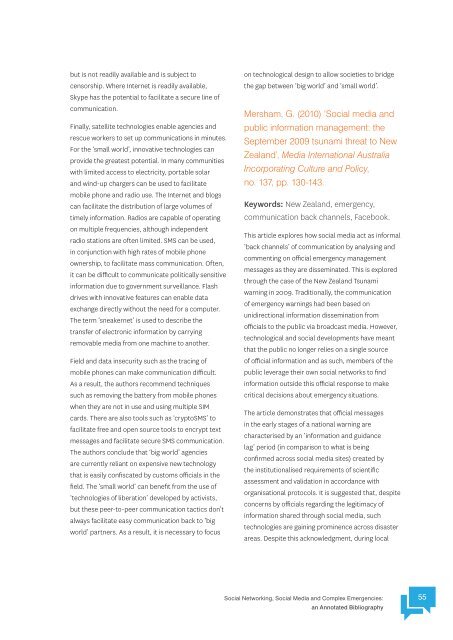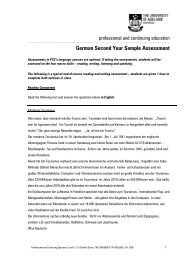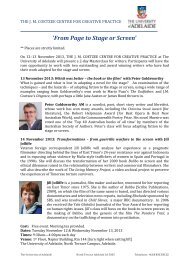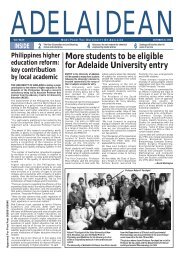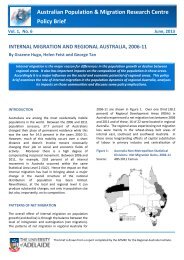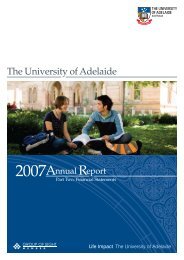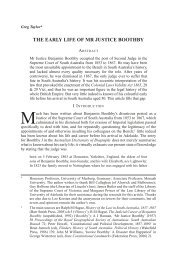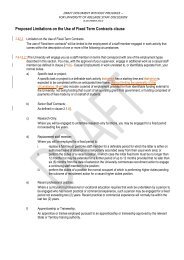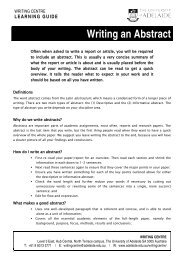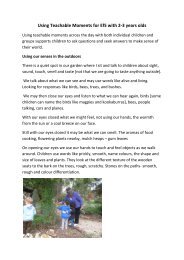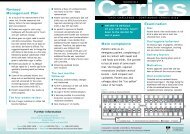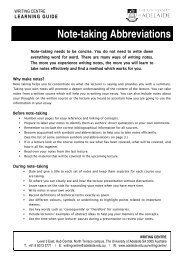Social Networking, Social Media and Complex Emergencies: an ...
Social Networking, Social Media and Complex Emergencies: an ...
Social Networking, Social Media and Complex Emergencies: an ...
You also want an ePaper? Increase the reach of your titles
YUMPU automatically turns print PDFs into web optimized ePapers that Google loves.
ut is not readily available <strong><strong>an</strong>d</strong> is subject to<br />
censorship. Where Internet is readily available,<br />
Skype has the potential to facilitate a secure line of<br />
communication.<br />
Finally, satellite technologies enable agencies <strong><strong>an</strong>d</strong><br />
rescue workers to set up communications in minutes.<br />
For the ‘small world’, innovative technologies c<strong>an</strong><br />
provide the greatest potential. In m<strong>an</strong>y communities<br />
with limited access to electricity, portable solar<br />
<strong><strong>an</strong>d</strong> wind-up chargers c<strong>an</strong> be used to facilitate<br />
mobile phone <strong><strong>an</strong>d</strong> radio use. The Internet <strong><strong>an</strong>d</strong> blogs<br />
c<strong>an</strong> facilitate the distribution of large volumes of<br />
timely information. Radios are capable of operating<br />
on multiple frequencies, although independent<br />
radio stations are often limited. SMS c<strong>an</strong> be used,<br />
in conjunction with high rates of mobile phone<br />
ownership, to facilitate mass communication. Often,<br />
it c<strong>an</strong> be difficult to communicate politically sensitive<br />
information due to government surveill<strong>an</strong>ce. Flash<br />
drives with innovative features c<strong>an</strong> enable data<br />
exch<strong>an</strong>ge directly without the need for a computer.<br />
The term ‘sneakernet’ is used to describe the<br />
tr<strong>an</strong>sfer of electronic information by carrying<br />
removable media from one machine to <strong>an</strong>other.<br />
Field <strong><strong>an</strong>d</strong> data insecurity such as the tracing of<br />
mobile phones c<strong>an</strong> make communication difficult.<br />
As a result, the authors recommend techniques<br />
such as removing the battery from mobile phones<br />
when they are not in use <strong><strong>an</strong>d</strong> using multiple SIM<br />
cards. There are also tools such as ‘cryptoSMS’ to<br />
facilitate free <strong><strong>an</strong>d</strong> open source tools to encrypt text<br />
messages <strong><strong>an</strong>d</strong> facilitate secure SMS communication.<br />
The authors conclude that ‘big world’ agencies<br />
are currently reli<strong>an</strong>t on expensive new technology<br />
that is easily confiscated by customs officials in the<br />
field. The ‘small world’ c<strong>an</strong> benefit from the use of<br />
‘technologies of liberation’ developed by activists,<br />
but these peer-to-peer communication tactics don’t<br />
always facilitate easy communication back to ‘big<br />
world’ partners. As a result, it is necessary to focus<br />
on technological design to allow societies to bridge<br />
the gap between ‘big world’ <strong><strong>an</strong>d</strong> ‘small world’.<br />
Mersham, G. (2010) ‘<strong>Social</strong> media <strong><strong>an</strong>d</strong><br />
public information m<strong>an</strong>agement: the<br />
September 2009 tsunami threat to New<br />
Zeal<strong><strong>an</strong>d</strong>’, <strong>Media</strong> International Australia<br />
Incorporating Culture <strong><strong>an</strong>d</strong> Policy,<br />
no. 137, pp. 130-143.<br />
Keywords: New Zeal<strong><strong>an</strong>d</strong>, emergency,<br />
communication back ch<strong>an</strong>nels, Facebook.<br />
This article explores how social media act as informal<br />
‘back ch<strong>an</strong>nels’ of communication by <strong>an</strong>alysing <strong><strong>an</strong>d</strong><br />
commenting on official emergency m<strong>an</strong>agement<br />
messages as they are disseminated. This is explored<br />
through the case of the New Zeal<strong><strong>an</strong>d</strong> Tsunami<br />
warning in 2009. Traditionally, the communication<br />
of emergency warnings had been based on<br />
unidirectional information dissemination from<br />
officials to the public via broadcast media. However,<br />
technological <strong><strong>an</strong>d</strong> social developments have me<strong>an</strong>t<br />
that the public no longer relies on a single source<br />
of official information <strong><strong>an</strong>d</strong> as such, members of the<br />
public leverage their own social networks to find<br />
information outside this official response to make<br />
critical decisions about emergency situations.<br />
The article demonstrates that official messages<br />
in the early stages of a national warning are<br />
characterised by <strong>an</strong> ‘information <strong><strong>an</strong>d</strong> guid<strong>an</strong>ce<br />
lag’ period (in comparison to what is being<br />
confirmed across social media sites) created by<br />
the institutionalised requirements of scientific<br />
assessment <strong><strong>an</strong>d</strong> validation in accord<strong>an</strong>ce with<br />
org<strong>an</strong>isational protocols. It is suggested that, despite<br />
concerns by officials regarding the legitimacy of<br />
information shared through social media, such<br />
technologies are gaining prominence across disaster<br />
areas. Despite this acknowledgment, during local<br />
<strong>Social</strong> <strong>Networking</strong>, <strong>Social</strong> <strong>Media</strong> <strong><strong>an</strong>d</strong> <strong>Complex</strong> <strong>Emergencies</strong>:<br />
<strong>an</strong> Annotated Bibliography<br />
55


